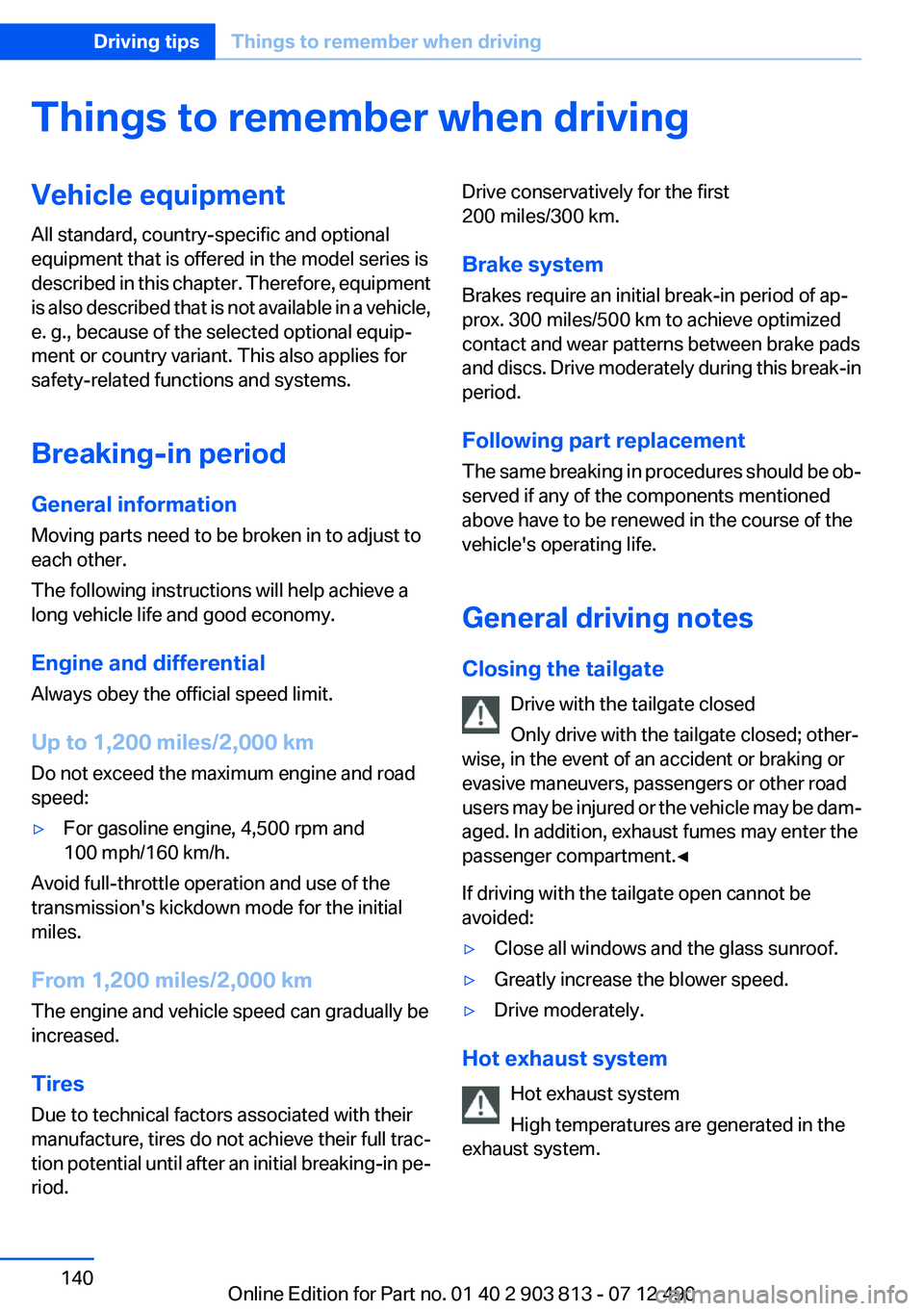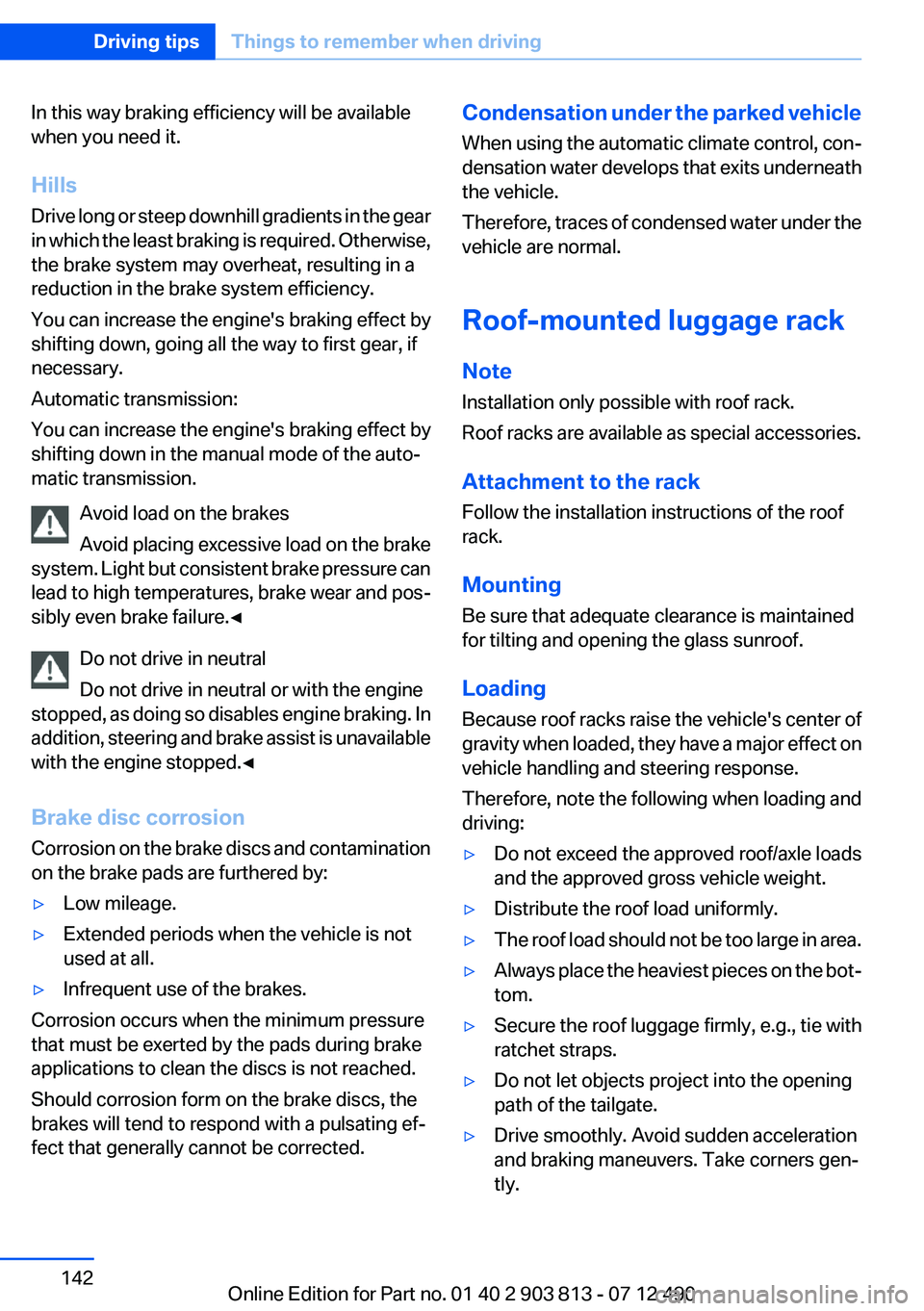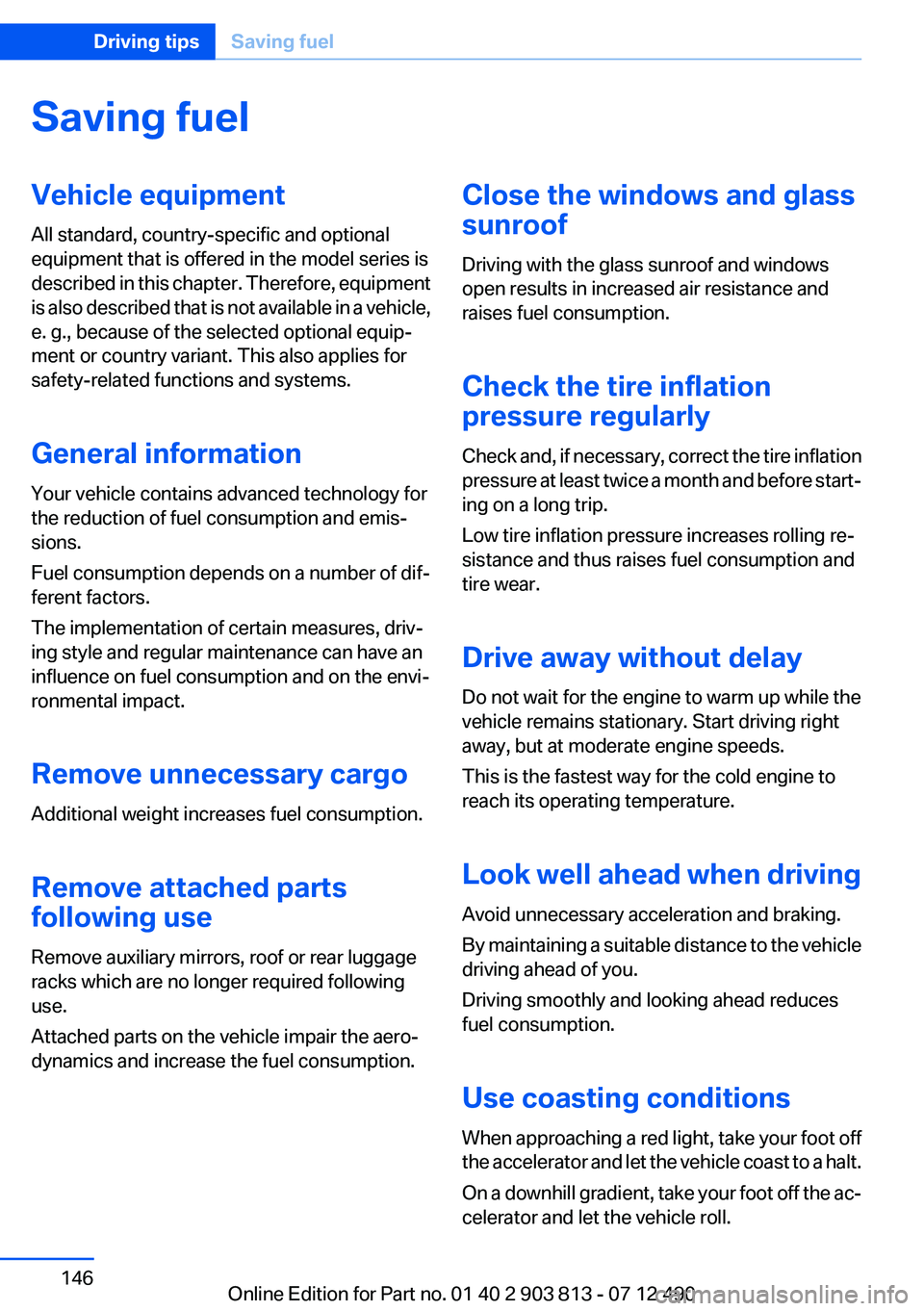2013 BMW X3 XDRIVE 28I sunroof
[x] Cancel search: sunroofPage 140 of 211

Things to remember when drivingVehicle equipment
All standard, country-specific and optional
equipment that is offered in the model series is
described in this chapter. Therefore, equipment
is also described that is not available in a vehicle,
e. g., because of the selected optional equip‐
ment or country variant. This also applies for
safety-related functions and systems.
Breaking-in period
General information
Moving parts need to be broken in to adjust to
each other.
The following instructions will help achieve a
long vehicle life and good economy.
Engine and differential
Always obey the official speed limit.
Up to 1,200 miles/2,000 km
Do not exceed the maximum engine and road
speed:▷For gasoline engine, 4,500 rpm and
100 mph/160 km/h.
Avoid full-throttle operation and use of the
transmission's kickdown mode for the initial
miles.
From 1,200 miles/2,000 km
The engine and vehicle speed can gradually be
increased.
Tires
Due to technical factors associated with their
manufacture, tires do not achieve their full trac‐
tion potential until after an initial breaking-in pe‐
riod.
Drive conservatively for the first
200 miles/300 km.
Brake system
Brakes require an initial break-in period of ap‐
prox. 300 miles/500 km to achieve optimized
contact and wear patterns between brake pads
and discs. Drive moderately during this break-in
period.
Following part replacement
The same breaking in procedures should be ob‐
served if any of the components mentioned
above have to be renewed in the course of the
vehicle's operating life.
General driving notes
Closing the tailgate Drive with the tailgate closed
Only drive with the tailgate closed; other‐
wise, in the event of an accident or braking or
evasive maneuvers, passengers or other road
users may be injured or the vehicle may be dam‐
aged. In addition, exhaust fumes may enter the
passenger compartment.◀
If driving with the tailgate open cannot be
avoided:▷Close all windows and the glass sunroof.▷Greatly increase the blower speed.▷Drive moderately.
Hot exhaust system
Hot exhaust system
High temperatures are generated in the
exhaust system.
Seite 140Driving tipsThings to remember when driving140
Online Edition for Part no. 01 40 2 903 813 - 07 12 490
Page 142 of 211

In this way braking efficiency will be available
when you need it.
Hills
Drive long or steep downhill gradients in the gear
in which the least braking is required. Otherwise,
the brake system may overheat, resulting in a
reduction in the brake system efficiency.
You can increase the engine's braking effect by
shifting down, going all the way to first gear, if
necessary.
Automatic transmission:
You can increase the engine's braking effect by
shifting down in the manual mode of the auto‐
matic transmission.
Avoid load on the brakes
Avoid placing excessive load on the brake
system. Light but consistent brake pressure can
lead to high temperatures, brake wear and pos‐
sibly even brake failure.◀
Do not drive in neutral
Do not drive in neutral or with the engine
stopped, as doing so disables engine braking. In
addition, steering and brake assist is unavailable
with the engine stopped.◀
Brake disc corrosion
Corrosion on the brake discs and contamination
on the brake pads are furthered by:▷Low mileage.▷Extended periods when the vehicle is not
used at all.▷Infrequent use of the brakes.
Corrosion occurs when the minimum pressure
that must be exerted by the pads during brake
applications to clean the discs is not reached.
Should corrosion form on the brake discs, the
brakes will tend to respond with a pulsating ef‐
fect that generally cannot be corrected.
Condensation under the parked vehicle
When using the automatic climate control, con‐
densation water develops that exits underneath
the vehicle.
Therefore, traces of condensed water under the
vehicle are normal.
Roof-mounted luggage rack
Note
Installation only possible with roof rack.
Roof racks are available as special accessories.
Attachment to the rack
Follow the installation instructions of the roof
rack.
Mounting
Be sure that adequate clearance is maintained
for tilting and opening the glass sunroof.
Loading
Because roof racks raise the vehicle's center of
gravity when loaded, they have a major effect on
vehicle handling and steering response.
Therefore, note the following when loading and
driving:▷Do not exceed the approved roof/axle loads
and the approved gross vehicle weight.▷Distribute the roof load uniformly.▷The roof load should not be too large in area.▷Always place the heaviest pieces on the bot‐
tom.▷Secure the roof luggage firmly, e.g., tie with
ratchet straps.▷Do not let objects project into the opening
path of the tailgate.▷Drive smoothly. Avoid sudden acceleration
and braking maneuvers. Take corners gen‐
tly.Seite 142Driving tipsThings to remember when driving142
Online Edition for Part no. 01 40 2 903 813 - 07 12 490
Page 146 of 211

Saving fuelVehicle equipment
All standard, country-specific and optional
equipment that is offered in the model series is
described in this chapter. Therefore, equipment
is also described that is not available in a vehicle,
e. g., because of the selected optional equip‐
ment or country variant. This also applies for
safety-related functions and systems.
General information
Your vehicle contains advanced technology for
the reduction of fuel consumption and emis‐
sions.
Fuel consumption depends on a number of dif‐
ferent factors.
The implementation of certain measures, driv‐
ing style and regular maintenance can have an
influence on fuel consumption and on the envi‐
ronmental impact.
Remove unnecessary cargo
Additional weight increases fuel consumption.
Remove attached parts
following use
Remove auxiliary mirrors, roof or rear luggage
racks which are no longer required following
use.
Attached parts on the vehicle impair the aero‐
dynamics and increase the fuel consumption.Close the windows and glass
sunroof
Driving with the glass sunroof and windows
open results in increased air resistance and
raises fuel consumption.
Check the tire inflation
pressure regularly
Check and, if necessary, correct the tire inflation
pressure at least twice a month and before start‐
ing on a long trip.
Low tire inflation pressure increases rolling re‐
sistance and thus raises fuel consumption and
tire wear.
Drive away without delay
Do not wait for the engine to warm up while the
vehicle remains stationary. Start driving right
away, but at moderate engine speeds.
This is the fastest way for the cold engine to
reach its operating temperature.
Look well ahead when driving
Avoid unnecessary acceleration and braking.
By maintaining a suitable distance to the vehicle
driving ahead of you.
Driving smoothly and looking ahead reduces
fuel consumption.
Use coasting conditions
When approaching a red light, take your foot off
the accelerator and let the vehicle coast to a halt.
On a downhill gradient, take your foot off the ac‐
celerator and let the vehicle roll.Seite 146Driving tipsSaving fuel146
Online Edition for Part no. 01 40 2 903 813 - 07 12 490
Page 205 of 211

Front passenger airbags, au‐tomatic deactivation 93
Front passenger airbags, indi‐ cator lamp 93
FTM Flat Tire Monitor 97
Fuel cap 152
Fuel consumption, current 78
Fuel consumption, refer to Average fuel consump‐
tion 82
Fuel filler flap 152
Fuel gauge 76
Fuel quality 154
Fuel, tank capacity 192
Fuse 177
G
Garage door opener, refer to Integrated universal remote
control 127
Gasoline 154
Gasoline quality 154
Gear change, automatic trans‐ mission 69
General driving notes 140
Glass sunroof, refer to Panor‐ amic glass sunroof 43
Glove compartment 134
Gross vehicle weight, ap‐ proved 191
H
Handbrake, refer to Parking brake 63
Hand-held transmitter, alter‐ nating code 128
Hazard warning flashers 178
HDC Hill Descent Control 103
Head airbags 91
Headlamp control, auto‐ matic 87
Headlamp courtesy delay fea‐ ture 87 Headlamp courtesy delay fea‐
ture via remote control 35
Headlamp flasher 66
Headlamp flasher, bulb re‐ placement 173
Headlamp glass 172
Headlamps 172
Headlamps, care 184
Headlamp washer system 66
Headliner 15
Head restraints 46
Head restraints, front 50
Head restraints, rear 51
Head-up Display 118
Head-up Display, care 186
Heavy cargo, stowing 144
Height, vehicle 190
High-beam Assistant 88
High beams 66
High beams/low beams, refer to High-beam Assistant 88
High beams, bulb replace‐ ment 173
Hill Descent Control HDC 103
Hills 142
Hints 6
Holder for beverages 135
Homepage 6
Hood 163
Horn 12
Hot exhaust system 140
HUD Head-up Display 118
Hydroplaning 141
I
Ice warning, refer to External temperature warning 77
Icy roads, refer to External temperature warning 77
Identification marks, tires 158
Identification number, refer to Important features in the en‐
gine compartment 163
iDrive 16 Ignition key, refer to Remote
control 30
Ignition off 59
Ignition on 59
Indication of a flat tire 95, 98
Individual air distribu‐ tion 120, 123
Individual settings, refer to Personal Profile 31
Inflation pressure, tires 155
Inflation pressure warning, tires 97
Info display, refer to Com‐ puter 81
Initializing, Flat Tire Monitor FTM 98
Initializing, Tire Pressure Mon‐ itor TPM 95
Instrument cluster 72
Instrument cluster, electronic displays 73
Instrument lighting 89
Integrated key 30
Integrated universal remote control 127
Intensity, AUTO program 123
Interior equipment 127
Interior lamps 90
Interior lamps via remote con‐ trol 35
Interior motion sensor 42
Interior rearview mirror 54
Interior rearview mirror, auto‐ matic dimming feature 54
Internet page 6
Interval display, service re‐ quirements 78
J
Jacking points for the vehicle jack 176
Jack, refer to Vehicle jack 176
Joystick, automatic transmis‐ sion 69
Jump-starting 179 Seite 205Everything from A to ZReference205
Online Edition for Part no. 01 40 2 903 813 - 07 12 490
Page 207 of 211

New wheels and tires 160
No Passing Information 79
Nylon rope for tow-starting/ towing 181
O
OBD Onboard Diagnos‐ tics 169
Obstacle marking, backup camera 115
Octane rating, refer to Gaso‐ line quality 154
Odometer 77
Office, see user's manual for Navigation, Entertainment
and Communication
Oil 165
Oil, adding 166
Oil additives 166
Oil change 166
Oil change interval, service re‐ quirements 78
Oil filler neck 166
Oil types, alternative 166
Oil types, approved 166
Old batteries, disposal 177
Onboard Diagnostics OBD 169
Onboard monitor, refer to Control Display 16
Onboard vehicle tool kit 171
Opening/closing from in‐ side 37
Opening/closing via door lock 36
Opening/closing with remote control 34
Operating concept, iDrive 16
Optional equipment, standard equipment 6
Outside air, refer to Automatic recirculated-air control 124
Overheating of engine, refer to Coolant temperature 76
Overtaking prohibitions 79 P
Paint, vehicle 184
Panic mode 35
Panoramic glass sunroof 43
Park Distance Control PDC 112
Parked-car ventilation 125
Parked vehicle, condensa‐ tion 142
Parking aid, refer to PDC 112
Parking brake 63
Parking lamps 86
Parking lamps, bulb replace‐ ment 173
Parking with Auto Hold 64
Partition net 132
Passenger side mirror, tilting downward 53
Pathway lines, backup cam‐ era 115
PDC Park Distance Con‐ trol 112
Performance Control 103
Personal Profile 31
Pinch protection system, glass sunroof 44
Pinch protection system, win‐ dows 43
Plastic, care 185
Power failure 177
Power windows 42
Pressure, tire air pres‐ sure 155
Pressure warning, tires 97
Profile, refer to Personal Pro‐ file 31
Programmable memory but‐ tons, iDrive 21
Protective function, glass sun‐ roof 44
Protective function, win‐ dows 43
Push-and-turn switch, refer to Controller 16, 17 R
Radiator fluid 167
Radio-operated key, refer to Remote control 30
Radio ready state 59
Radio, see user's manual for Navigation, Entertainment
and Communication
Rain sensor 67
Rear lamps 175
Rear socket 130
Rearview mirror 52
Rear window de‐ froster 122, 124
Recirculated-air filter 125
Recirculated-air mode 121, 124
Recommended tire brands 161
Refueling 152
Remaining range 77
Remote control/key 30
Remote control, malfunc‐ tion 35
Remote control, universal 127
Replacement fuse 177
Replacing parts 171
Replacing wheels/tires 160
Reporting safety defects 8
Reserve warning, refer to Range 77
Resetting, Tire Pressure Mon‐ itor TPM 95
Retaining straps, securing cargo 144
Retreaded tires 161
Roadside parking lamps 87
Roller sunblinds 43
RON gasoline quality 154
Roof load capacity 191
Roof-mounted luggage rack 142
Rope for tow-starting/tow‐ ing 181 Seite 207Everything from A to ZReference207
Online Edition for Part no. 01 40 2 903 813 - 07 12 490